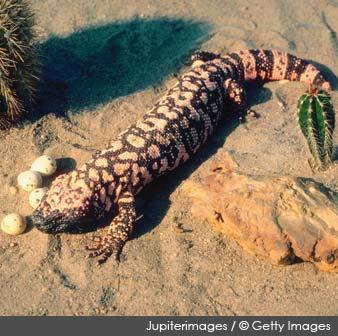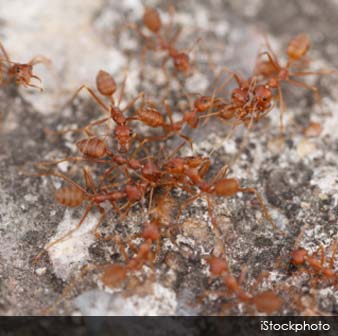For “Mammal Monday”:
10 Creatures and Critters Your Pet Should Avoid:

- Porcupines
- Porcupines are found all over the U.S. If your dog runs into one of these rodents in the woods, those mean-looking quills can easily embed themselves in your pet's skin, causing pain and anxiety.
- Typically, a lengthy visit to the vet is required to remove all the quills and treat any serious puncture wounds or infection.

Rattlesnakes
If you take your dog camping, hiking, or elsewhere in the great outdoors, you should be aware that rattlesnake bites pose a significant danger. The most common bite site on a dog is the muzzle. A rattler's venom causes swelling, oozing blood, and death of tissues. Bleeding problems can occur for several days following a bite and can put your dog's life at risk.
Rattlesnakes inhabit many regions throughout the U.S., but the variety considered most deadly, the Mojave rattler, is found in the Southwest.
If your dog is bitten by a rattlesnake, keep him quiet, limit his ability to move to inhibit the spread of venom, and get him to your vet or an animal emergency clinic immediately.

Bufo Marinus (Giant toads)
The giant toad, also known as the Cane toad, Marine toad and Bufo toad, also poses a considerable danger for dogs. This toad produces a toxin on its skin that can cause heart failure in a dog who simply picks the toad up in its mouth. Symptoms of poisoning by a giant toad include pain, drooling, crying, bright red gums and loss of coordination.
Giant toads are found in Florida, Hawaii and the southern most areas of the U.S.
If your dog comes in contact with a giant toad, gently rinse her mouth out thoroughly with water. Pour or spray the water into the side of her mouth so it flows out the other side without getting into the throat. Seek veterinary attention right away.

Brown Recluse Spiders
The bite of this spider isn't immediately impressive, but the site of the bite soon develops into a large, deep wound that is difficult to treat. The injury can actually require surgery to heal properly, and in some cases causes permanent damage. Seek veterinary attention for your pet immediately if he's bitten by a brown recluse.
These spiders are most often encountered in states in the Midwest and south central regions of the U.S.

- Gila Monsters
Gila monster encounters are uncommon, but memorable. If your dog is unlucky enough to be bitten by one, the lizard will latch on, chew, and inject venom. Once latched on to your pet, a gila monster can be very hard to remove, and in fact, many dogs get rushed to the vet or emergency clinic with the creature still attached and chewing away. The bite is painful and can cause neurological signs. Fortunately, it is rarely life-threatening.
Gila monsters are found in the Southwest U.S. If your dog is bitten, don't pull the lizard off using force as this can leave teeth embedded in your dog's skin. Spraying water or rubbing alcohol on the lizard's nose will cause it to let go and drop off your dog.

Coyotes
Coyotes are predators that normally hunt small wild mammals. However, every spring and summer family pets also become prey for hungry or fearless coyotes.
Coyotes inhabit all of North America. If you live near undeveloped land where coyotes are likely to roam, you should keep a close eye on your pets when you let them outdoors — especially if they're small, and especially after dark. Coyotes will also be attracted to pet food left outside, garbage cans, and water sources like ponds or even a fountain in the yard.

Fire Ants
- If you live in the southern U.S., you're probably familiar with fire ants. Dogs who sniff along the ground can run their noses right into a colony of fire ants. The bites of these ants really burn, and many dogs wind up seeing their vets for sore paws and noses.
Fire ant bites are painful and unpleasant, but they aren't usually serious. If your dog runs into a swarm of fire ants, rinse the sore area with cool water and call your vet for next steps, if necessary.

Bees
If your dog gets her first bee sting, she'll probably have a bit of pain from the sting and some mild swelling. However, subsequent bee stings can result in more severe reactions. Fatal reactions in canines are uncommon, but not unheard of. In addition, Africanized bees are very aggressive.
No matter where you live in the U.S., there are bees. Africanized honey bees are found in the Southwest, Florida, Arkansas, Oklahoma and Texas.
If your dog is stung by a bee, contact your vet immediately. If your pet can't be seen right away, give a child's dose of antihistamine to a small dog or an adult dose to a large dog.

Skunks
Most people think the only danger from skunks is the wildly stinky spray they release when threatened. But skunks also have very powerful front claws that can injure your pet. They can carry rabies as well.
If your pet encounters a skunk and gets sprayed, read here for the best way to get rid of the smell.

Scorpions
Scorpions are found primarily in the southwestern U.S. and pose a real danger to both pets and people. If you live in an area where scorpions are common, keep a close eye on your pet. If he's tracking something on the ground, make sure it isn't a scorpion.
Scorpion venom can be deadly. If you suspect your pet has encountered a scorpion, if he's limping or seems sick after being outdoors, call your vet or an animal emergency clinic immediately.
________
Tennessee Walking Horse Abuse, Published on Aug 28, 2012 by hsus
“Convicted horse trainer Barney Davis discusses how rampant horse soring is in the Walking Horse industry.
---------
Cruelty Behind Tennessee Walking Horses
“In the Tennessee Walking Horse Industry, it all comes down to one competition: Celebration. To win, horse trainers go to cruel extremes.” TAKE ACTION: https://secure.humanesociety.org/site/Advocacy?cmd=display&page=UserActio...
Horse soring bill faces its share of resistance


WASHINGTON — “Two House members introduced legislation Thursday to strengthen laws against soring of Tennessee Walking Horses, but supporters warned that the bill would not be easy to pass.
While soring — inflicting pain on horses’ legs, joints and hooves so that their gait becomes more high stepping — is already against the law, Reps. Ed Whitfield, R-Ky., and Steve Cohen, D-Memphis, said their bill would amend the Horse Protection Act of 1970 to:
• Put the Agriculture Department in charge of licensing inspectors and have it assign an inspector to any show that requests one. It also increases the number of inspectors the agency can use for surprise inspections at shows that don’t request a licensed inspector. Funding for the increase in inspectors would come from giving the department a share of the entrance fees that horse owners pay at shows.
• Outlaw the use of “action devices” that rub on sore areas of a horse to increase pain.
• Increase penalties for soring, with fines of up to $5,000 or imprisonment for up to three years or both.
• Increase fines from $2,000 to $4,000 for hiring an unlicensed inspector.
Whitfield and Cohen announced the bill at a Capitol Hill news conference where they also showed an undercover video aired by ABC News’ “Nightline” that showed horses wrenching in pain because of soring techniques employed by trainers. No matter what the industry says, “it appears this is a widespread practice,” Whitfield said.
About the Tennessee Walking Show Horse Organization, in particular, he added, “I think it’s pretty obvious they have been turning their eyes away.” More at: http://www.tennessean.com/article/20120914/NEWS21/309140062/Horse-soring-bill-faces-its-share-resistance?nclick_check=1
Related Links
- Tennessee Walking Horse Industry & Soring Timeline
- Federal, local horse inspectors release conflicting Celebration violation rates
- Tennessee Walking Horse trainer Jackie McConnell gets probation, $75,000 fine
- Horse trainer Jackie McConnell sentenced to probation and a fine for walking horse abuse
- Walking horse industry, USDA standoff intensifies
- Inspection issues at Tennessee Walking Horse Celebration spark some friction
- Veterinary groups seek ban on horse soring devices
- Walking Horse board slaps trainer Jackie McConnell with lifetime suspension
- Humane Society releases video of Tennessee Walking Horse abuse
---------
Bill Would Outlaw Horse Soring
“U.S. lawmakers from Kentucky and Tennessee have introduced a bill intended to outlaw horse "soring," an abusive practice of intentionally and repeatedly injuring the forelegs of horses in order to enhance their performance in competitive events.
Most of often used in the training of Tennessee Walking Horses to accentuate the breed's distinctively exaggerated gait rewarded in competitions, soring is accomplished by blistering the horse's forelegs with chemicals or forcing the horse to wear devices that irritate or actually cut its legs.” More at: http://usgovinfo.about.com/b/2012/09/19/bill-would-outlaw-horse-soring.htm
_______
Another reminder for WCS Run for the Wild ![]()
 “Mark your calendar for an exciting day at WCS's New York Aquarium in Coney Island on Saturday, October 6. At this family-oriented 5K run/walk on Brooklyn's storied boardwalk, participants will make tracks for walruses and other endangered wildlife at the aquarium and around the globe. Your registration includes:
“Mark your calendar for an exciting day at WCS's New York Aquarium in Coney Island on Saturday, October 6. At this family-oriented 5K run/walk on Brooklyn's storied boardwalk, participants will make tracks for walruses and other endangered wildlife at the aquarium and around the globe. Your registration includes:
- All-day access to the New York Aquarium
- Free commemorative t-shirt
- Staggered starts for runners and walkers/ families
- Prizes for fundraisers of all levels, including kisses from the aquarium's sea lions!
________
On This Day:
Muhammad completes Hegira, Sep 24, 622:
“On this day in 622, the “prophet” Muhammad completes his Hegira, or "flight," from Mecca to Medina to escape persecution. In Medina, Muhammad set about building the followers of his religion--Islam--into an organized community and Arabian power. The Hegira would later mark the beginning (year 1) of the Muslim calendar. When he was 25, Muhammad married a wealthy widow 15 years his senior and lived the next 15 years as a merchant.
From time to time, Muhammad spent nights in a cave in Mount Hira north of Mecca, ruminating on the social ills of the city. Around 610, he had a vision in the cave in which he heard the voice of a majestic being, later identified as the angel Gabriel, say to him, "You are the Messenger of God." Thus began a lifetime of religious revelations, which he and others collected as the Qur'an, or Koran.
Muhammad regarded himself as the last prophet of the Judaic-Christian tradition, and he adopted aspects of these older religions' theologies while introducing new doctrines. Muhammad's monotheistic religion came to be called Islam, meaning "surrender [to God]," and its followers were Muslims, meaning "those who have surrendered." His inspired teachings would bring unity to the Arabian peninsula, an event that had sweeping consequences for the rest of the world.
In the summer of 621, an entourage of 12 men came to Mecca from Medina, an oasis community 200 miles to the north. They were ostensibly making a pilgrimage to Mecca's pagan shrines, but they had actually come to meet with Muhammad and profess themselves as Muslims. In 622, a larger group of converts from Medina came to Mecca and took an oath to Muhammad to defend him as their own kin. Muhammad immediately encouraged his Meccan followers to make their way to Medina in small groups. When city authorities learned that the Muslims had begun an exodus, they plotted to have the prophet killed. Under this threat, Muhammad slipped away unnoticed with a chief disciple and made his way to Medina, using unfrequented paths. He completed the celebrated Hegira (Hijrah in uncorrupted Arabic) on September 24, 622. The history of Islam had begun.
He was now the strongest man in Arabia. During the next few years, most of the peninsula's disparate Arab tribes came to him to ask for alliance and to convert to his religion. By his death, on June 8, 632, Muhammad was the effective ruler of most of Arabia, and his rapidly growing empire was poised for expansion into Syria and Iraq.
Within 20 years, the Byzantine and Persian empires had fallen to the prophet's successors, and during the next two centuries vast Arab conquests continued. The Islamic empire grew into one of the largest the world has ever seen, stretching from India, across the Middle East and Africa, and up through Western Europe's Iberian peninsula. The spread of Islam continued after the fragmentation of the Arab empire, and many societies in Africa and Asia voluntarily adopted Muhammad's religion. Today, Islam is the world's second-largest religion.”
_______
Honda Motor Company is incorporated, Sep 24, 1948:
“On this day, motorcycle builder Soichiro Honda incorporates the Honda Motor Company in Hamamatsu, Japan. In the 1960s, the company achieved worldwide fame for its motorcycles (in particular, its C100 Super Cub, which became the world's best-selling vehicle); in the 1970s, it achieved worldwide fame for its affordable, fuel-efficient cars. Today, in large part because of its continued emphasis on affordability, efficiency and eco-friendliness (its internal motto is "Blue skies for our children"), the company is doing better than most.
Before he founded the company that bore his name, Soichiro Honda was a drifter and a dreamer. He bounced from one mechanic's job to another, and also worked as a babysitter, a race car driver and an amateur distiller. Even his wife said he was a "wizard at hardly working." In 1946, he took over an old factory that lay mostly in ruins from wartime bombings, though he did not have much of a plan for what he would do there. First he tried building what he called a "rotary weaving machine"; next he tried to mass-produce frosted glass windows, then woven bamboo roof panels. Finally, after he came across a cache of surplus two-stroke motors, he had an idea: motorbikes.
Honda adapted the motors to run on turpentine and affixed them to flimsy cycle frames built by workers at the Hamamatsu factory. The bikes sold like hotcakes to people desperate for a way to get around in postwar Japan, where there was virtually no gasoline and no real public transit. Soon enough, Honda had sold out of those old engines and was making his own. In 1947, the factory produced its first complete motorbike, the one-half horsepower A-Type (nicknamed "The Chimney" because it was so smoky and smelly). After the company's incorporation, Honda produced a more sophisticated bike: the 1949 steel-framed, front- and rear-suspended D-Type that could go as fast as 50 miles per hour. At the end of the 1950s, it introduced the Cub, a Vespa clone that was especially popular with women and was the first Honda product to be sold in the United States.
Starting in the 1960s, the company produced a few small cars and sporty racers, but it wasn't until it introduced the Civic in 1973 that it really entered the auto market. The car's CVCC engine burned less fuel and could pass American emissions tests without a catalytic converter; as a result, the car was a hit with American drivers frustrated by rising gasoline costs. The slightly larger, plusher 1976 Accord won even more fans, and in 1989 it became the most popular car in the United States.
More recently, the customer base for Honda's efficient, environmentally friendly cars has grown exponentially. Its tiny Fit car is selling well, and the company has plans to introduce a five-door hybrid model that will compete with Toyota's Prius.
Soichiro Honda was inducted into the Automotive Hall of Fame in 1989. He died two years later at the age of 84.”
_______
Yesterday:
Not much going on. Jay called to remind me that Maddie needed her Revolution, (flea, tick, mite, heartworm preventative). So I took it, and Misty down there, and we had our walk. Misty and I went across the street, so we talked to Muffie and her ‘Dad’, then I had coffee on Jay’s mother’s porch, so Misty talked to little Maddie. Jay had his water hose going, so he rinsed the dust off the Puddle Jumper.
Jay has bought an antenna that he says will get 40 TV channels out of the air, I’ll believe it when I see it. If so, I want one, and get rid of the expensive cable. Misty and I stopped at Sam’s to clean and medicate Mikey’s ears.
Then I went over some paperwork, and emails. Also, I found the phone number for eBay’s Resolution Center. A seller did not issue a refund for an item I returned to them, as it was ‘Not as Advertised’. The case has been ‘open’ for some time, but nothing had been done about it. eBay said they will issue the refund, and take it up with the seller. That’s nice, I guess you just have to jostle someone.
Since Ray and I worked on the TV coax cable, the cabinet we moved is still not where it belongs in the workshop as I can’t move it back by myself. So I vacuumed where it goes, but I found a hole under the utility sink where mice could get in. The contractors had made the hole too large for the drain, so that will have to be fixed first. Always something! Maybe the hillbilly way, and cut a license plate to go around it? The cabinet is in the way of my washing machine, so doing the laundry was postponed, but I did change the sheets.
The weather has been lovely, and the AC hasn’t been needed except in the afternoons for the last few days.




















No comments:
Post a Comment